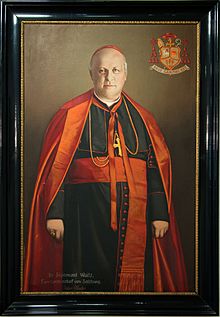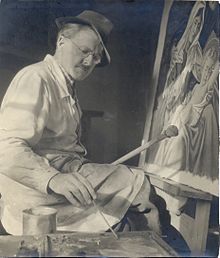Peter Thaler
Peter Thaler (born December 19, 1891 in Oberndorf (then the municipality of St. Johann in Tirol ), † March 12, 1978 in St. Johann in Tirol) was an Austrian painter, folk actor and local researcher. He shaped the cultural life of St. Johann in Tirol and the surrounding area for half a century, was in great demand as a portrait painter and wrote several plays with local historical content.
Life
Thaler was born on December 19, 1891 as the son of farmers Peter and Katharina Thaler, owners of the Kirchern farm in the hamlet Haslach near Oberndorf in Tyrol , which at that time was still part of the municipality of St. Johann in Tyrol.
His teacher Josef Plankensteiner discovered Thaler's artistic talent at the St. Johann elementary school, encouraged him and paved the way for his later career as a painter. In 1905 Peter Thaler began training with the church painter Anton Schnabel in Kitzbühel , where he learned art and decorative painting. He passed the journeyman's examination in Salzburg in 1909 and the master’s examination in 1912 after further training with the Munich academic painter Joseph Albrechtskirchinger.
In 1914, Thaler joined the 3rd Regiment of the Tyrolean Kaiserjäger in Trento during the First World War . After his basic training, he was integrated into the Kaiserschützen Regiment No. 3 and was deployed on the Three Peaks Plateau in 1915 . Later to the Rovereto front, where he was used as a scout and had to draw the enemy's positions. In 1916 he fell ill with typhus , was transferred to the military hospital in Trento and then came to Bohemia to relax . In 1917 he was finally transferred to the Imperial and Royal Navy in the Dalmatian port city of Cattaro , where he stayed until the end of the war and then returned to St. Johann in an adventurous manner from the Balkans in autumn 1918.
Even before the war, Thaler played in a theater group in St. Johann in Tirol. After his return from the First World War, he founded the Leukentaler Volksbühne in 1919 with 18 theater enthusiasts, whose driving force he was for almost 50 years as chairman, director, set painter, make-up artist and author of several plays.
For economic reasons - shortly after the First World War it was not yet possible to open a painting business in St. Johann - Thaler ran a workshop in Reit im Winkl from 1920 to 1923 , where he also founded a theater association. In 1923 he opened his business in St. Johann in Tirol. He worked with six to eight assistants, who primarily carried out the simple painting and decorating work, while he was mainly responsible for decorative paintings and artistic work such as portraits and commissioned paintings.

In 1929 he married Berta Brandstätter, who came from Gmünd in Carinthia . There were three children from this marriage: Berta, Katharina and Peter.
In 1943, at the age of 52, Thaler had to enter the Second World War. He was known locally as an opponent of the regime, was denounced several times and called up to a penal company to fight partisans in Yugoslavia. A Bavarian officer who used to play theater with him was able to arrange for his transfer to Lochau in Vorarlberg, where Thaler was used to paint military vehicles.
After the war he continued his painting business in St. Johann in Tirol. In 1948 he restored the hermitage near St. Johann free of charge and created the ceiling painting "Mariae Heimsuchung." The material costs for the restoration were taken over by the Volksbühne. After the Second World War, Thaler organized several charity events for invalids and war victims with his association and financed the construction of a pedestrian walkway over the Kitzbüheler Ache with the Volksbühne .
Folk actor and local researcher
Thaler shaped the cultural life of St. Johann in Tirol for over half a century as a painter and theater maker. With the Leukentaler Volksbühne he performed the great classics of the Tyrolean folk theater, especially pieces by Anzengruber , Ganghofer , Rauchegger and Schönherr . The showpiece was the drama "Die Räuber vom Glockenhof", which Thaler brought to the stage in several productions. The "Glockenhofer" was also his star role, which even brought him an offer to go to Berlin as an actor , which he turned down.
Peter Thaler usually painted his own backdrops for the various plays. In his life he has created 38 complete stage sets. He staged a total of 98 pieces and staged almost 1,000 performances, mainly in St. Johann, but also on numerous guest appearances in Tyrol , Salzburg and Bavaria .
Thaler was very interested in regional history and worked as a local researcher. He wrote several writings on local history - mainly on medieval topics and castle research in the Leukental - as well as plays with historical content. His plays "The founding of Spital in der Weitau, Hermitage Maria Blut, The Chapel on the Vogelwand, Speckbacher's Headquarters 1809, The Kössnerbahn" and the comedy "Die Geisteralm am Kitzbüheler Horn " were performed with great success.
In 1966, after almost 50 years, Thaler resigned from his functions as chairman and director of the Volksbühne. He was honorary chairman of the Volksbühne St. Johann in Tirol and holder of the golden medal of merit of the regional association of the Tyrolean folk theaters as well as the medal of honor of the traditional costume club Edelraute, which emerged from the Volksbühne. Peter Thaler died on March 12, 1978 at the age of 86.
The artistic work
Peter Thaler painted his pictures in oil or mixed media on canvas, cardboard or hardboard. Due to his well-founded training to learn art painting in the traditional form like a craft, he was able to fully exploit the possibilities of the various techniques and used them in very different ways - both according to artistic as well as very practical considerations. On the one hand, there are some paintings by him in the classic and particularly elaborate old master's glaze technique on canvas, on the other hand, several pictures in prima painting on cardboard have been preserved, which is why one can assume that he will probably also transfer the execution of his orders in the various techniques to the financial ones The client's options.
Thaler was known for his portrait painting , in which he showed a high level of technical skill. He not only created mere images of people, but also mastered the art of bringing the essence and character of the person depicted to the fore. Particularly noteworthy in this context are the portrait of the Prince Archbishop of Salzburg, Sigismund Waitz , the portrait of St. Johann Dechant Josef Ritter as well as the portraits of some regional dignitaries, which he immortalized in oil on canvas using the elaborate glaze technique of the old masters.
Thaler's landscapes are often depictions of his immediate homeland and mostly show idyllic scenes with the Kaiser Mountains in the background. He was often commissioned to paint typical Tyrolean farmhouses, in front of which people in costume stand and in the background of which a mountain range rises. Thaler is fully connected to the classical tradition of the 19th century, and this is where his traditional training and the influence of his teacher Joseph Albrechtskirchinger are best recognizable. Thaler paints these pictures in a style that was common in the academies of the 19th century. He, who was not an academic painter himself, but learned painting in the craftsmanship sense, carried this traditional painting style well into the 20th century, while other trends had long been the rule at the art academies.
This artistic attitude fully corresponds to his view of the world and his personal interests. Peter Thaler was a person who was deeply conscious of tradition and who dealt intensively with the history and customs of his homeland. Historical themes can also be found in his pictures - both copies after Franz von Defregger and his own compositions; and also for theatrical performances, festivities and parades he processed historicizing motifs by illustrating his ideas about the results of his local history research.
His murals adorn the facades of the Huber brewery in St. Johann in Tirol , the Dorfwirt in Oberndorf in Tirol , the Wintersteller inn in Kirchdorf in Tirol , the Waidring elementary school , the dairy in Knittelfeld , the gendarmerie buildings in Ried and Erpfendorf and some private houses in Innsbruck , Pfunds and St. Johann in Tirol.
Appreciation
Thaler remained attached to the artistic tradition of the 19th century throughout his life and consciously did not participate in current trends in international art development. His qualities lie precisely in this adherence to a painting style that has been handed down over centuries, which requires a high level of technical skill but which in the course of the 20th century threatened to be more and more forgotten. Of particular importance are his portraits, which have a timeless quality due to their expressiveness.
Museums
On the occasion of the 125th birthday of Peter Thaler, the Museum St. Johann in Tirol dedicated an exhibition to him, and the Hannes Hofinger publishing house published a book about Peter Thaler.
Works by Peter Thaler are in the Museum St. Johann in Tirol and in the Cathedral Museum Salzburg .
literature
- Peter Fischer: Laienspiel in St. Johann in Tirol , in: St. Johann in Tirol - Nature and Man in Past and Present, St. Johann in Tirol 1990, Volume II, p. 714 ff
- Festschrift 75 years Volksbühne St. Johann in Tirol , St. Johann in Tirol 1994.
- Peter Fischer: Peter Thaler 1891 - 1978 , Hannes Hofinger Verlag, St. Johann in Tirol 2016, ISBN 978-3-7412-5257-0
- Werner Mitterer: St. Johann originals, portraits - characters - life pictures , St. Johann in Tirol 2003
- On the 125th birthday of the St. Johann artist and folk actor Peter Thaler, Tiroler Heimatblätter 1/2017 page 40 ff
| personal data | |
|---|---|
| SURNAME | Thaler, Peter |
| BRIEF DESCRIPTION | Austrian painter, folk actor and local researcher |
| DATE OF BIRTH | December 19, 1891 |
| PLACE OF BIRTH | St. Johann in Tirol |
| DATE OF DEATH | March 12, 1978 |
| Place of death | St. Johann in Tirol |



